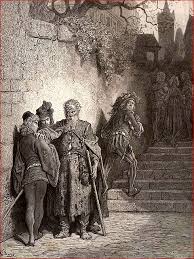Coleridge, S. (1970). Introduction. In M. Rose (Ed.).
The rime of the ancient mariner. New York, NY: Dover Publications, Inc..

This publication of the poem
The Rime of the Ancient Mariner by Samuel Coleridge contains
prints from
engravings etched by Gustove Dore'. While this poem is typically used for older students (it can also be found in an anthology I used in college), this particular
format can be used for students of any age if the teacher is patient and willing to explain the vocabulary. The addition of the illustrations by the French engraver Gustove Dore' helps to explain the plot of the narrative poem.
The prints are on the opposing pages of the text and are very relevant to the poem and help explain the text. The first example is on the opening pages of the poem (pp. 2-3)
when the narrator is explaining how the mariner stopped him when he was with three of his friends attending a wedding.

The illustrations also help younger students with
visualizing the story. This is demonstrated on pages 15 and 17. The content of the poem is talking about an albatross, which most students may not be familiar. The
pictures depict the albatross sitting while the sailors feed and admire the bird in the first scene and when the mariner shoots the bird with his crossbow in the second. These
pictures would enable the students to realize that an albatross is a large sea bird and what it looks like.

The prints also help students understand the events that are taking place, such as when Death and Life-in-Death are casting dice (pg. 29). In the poem, the two spirits are seeing who gets the souls of the members of the crew. Later when the poem makes reference to "lights" lifting from the bodies of the dead sailors, the print with the band of angels provides a visual for the reader (pg. 59).
I enjoy reading this poem to my classes and this illustrated version has made it a favorite for my kids as well.
The 698 line poem itself is a treasure for teaching the elements of poetry. First, the poem is written in ballad stanza, which is an iambic foot (unit of measure that is a pattern of an unstressed syllable followed by a stressed syllable) alternating between lines of trimeter (3 feet per line) and tetrameter (4 feet per line). Ballad stanza is what produces the song-like quality to this type of poem. Ballad stanza also has end rhyme with a rhyme pattern of ABCB. There are instances where the poem varies from this format, such as on pages 8, 52, and 60. There is also indirect personification: the Moon, the Sun, the Albatross, Death, and Life-in Death are all examples of personification. These are considered personification because Coleridge capitalized them, implying that they are names, a human quality.
The narrative style in which the poem is written means that it tells a story that has developing (round) characters (the wedding guest and the mariner), a progressive, complex linear plot (a story within a story that has an introduction, rising action, climax, falling action, and resolution), and a definitive setting (on a ship on the ocean). This is a lesson that I look forward to doing every year and this kids enjoy as well.
No comments:
Post a Comment